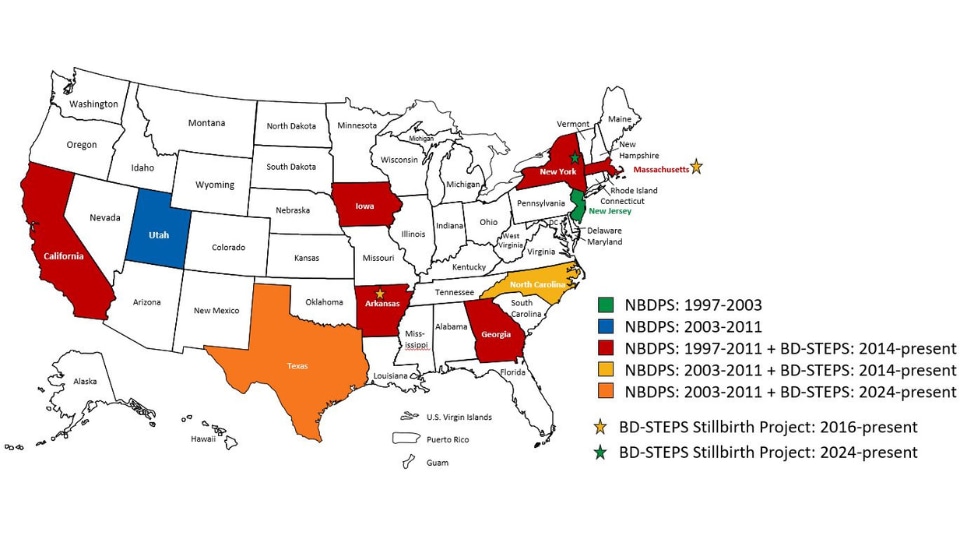Key points
- The National Birth Defects Prevention Study (NBDPS) is one of the largest studies on causes of birth defects in the US.
- NBDPS included deliveries from 1997 to 2011.
- The Birth Defects Study to Evaluate Pregnancy exposureS (BD-STEPS) began with deliveries in 2014 and is ongoing.

What it is
The National Birth Defects Prevention Study (NBDPS) and the Birth Defects Study To Evaluate Pregnancy exposureS (BD-STEPS) are studies of risk factors for birth defects and/or stillbirth.
BD-STEPS extends and focuses the efforts of the NBDPS and includes research into risks and potential causes of stillbirth. The Centers for Birth Defects Research and Prevention (CBDRP) conducted these studies. The CBDRP are a collaborative group of Centers funded by CDC to study birth defects and stillbirth.
Centers are in ten states: Arkansas, California, Georgia, Iowa, Massachusetts, New Jersey, New York, North Carolina, Texas, and Utah. These states had existing birth defects surveillance programs and have expertise in birth defects tracking and research. CDC coordinates the CBDRP and participates as the Georgia Center. Through the NBDPS and BD-STEPS, the CBDRP has built an infrastructure for birth defects and stillbirth research.

Why research important
CDC works to identify causes of birth defects and stillbirth and find opportunities for prevention. Understanding the potential causes of birth defects and stillbirth can lead to improved recommendations, policies, and services. NBDPS and BD-STEPS are critical pieces of CDC's birth defects and stillbirth research activities.
Importance of NBDPS
The NBDPS is one of the largest studies on the causes of birth defects in the United States. Researchers conducted interviews for women with deliveries from 1997 to 2011 and included
- Over 30,000 interviews of women who had pregnancies with birth defects
- Over 10,000 interviews of women whose pregnancies without birth defects
NBDPS data made key contributions toward understanding risk factors of having a pregnancy affected by a birth defect, including:
- Certain medication use by women before and during pregnancy
- Diabetes and obesity
- Smoking
Importance of BD-STEPS
The BD-STEPS is a study on risk factors for birth defects and/or stillbirth. BD-STEPS:
- Began with deliveries on January 1, 2014
- Includes interviews of women with affected pregnancies (with birth defects or that ended in stillbirth)
- Includes interviews of women with unaffected pregnancies
- Conducted over 6,000 interviews so far
In 2016, CDC expanded funding for the CBDRP's stillbirth work. Understanding the risks and causes of birth defects and stillbirths can help us prevent them. Certain Centers expanded their birth defects surveillance systems to find all pregnancies that end in stillbirth. These programs are:
- Looking at new ways to find and study stillbirths
- Interviewing women who lost their baby during pregnancy
- Finding common experiences and exposures among those women
- Sharing this information with the medical community and the public
Through BD-STEPS, researchers continue to study possible risk factors for having a pregnancy affected by a birth defect or stillbirth, including:
- Diabetes and obesity
- Infections
- Lifestyle factors
- Social determinants of health
- Certain medication use during pregnancy
What's ahead
Interviews for NBDPS were completed in March 2013, but researchers continue to analyze this rich source of information. BD-STEPS interviews are ongoing and data from the study are being analyzed. Researchers have published more than 400 scientific papers using NBDPS and/or BD-STEPS data.
Resources
For information on study questionnaires or how to apply for access to study data, visit NBDPS and BD-STEPS Public Access Procedures.
For more information about CDC's work on stillbirth, visit CDC Activities.
